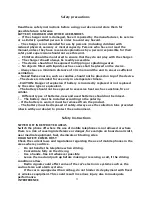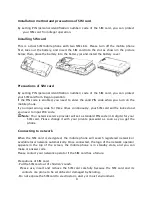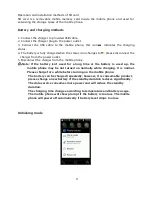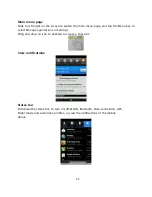
3
Safety precautions
Read these safety instructions before using your device and store them for
possible future reference
BATTERY, CHARGER, AND OTHER ACCESSORIES
-
If the charger cord is damaged, have it repaired by the manufacturer, its service
or a similarly qualified person in order to avoid any hazard.
-
The charger is not intended for use by persons (including children) with
reduced physical, sensory or mental capacity. Persons who have not read the
manual, unless they have received explanations by a person responsible for their
safety and supervision should not use this unit.
-
Children should be monitored to ensure that they do not play with the charger.
-
The charger should always be readily accessible.
-
The device should not be exposed to dripping or splashing water.
-
No objects filled with liquids such as vases shall be placed on the device.
-
Always leave a minimum distance of 10 cm around the unit to ensure su
ffi
cient
ventilation.
-
Naked flame sources, such as candles, should not be placed on top of the device.
-
The device is intended for use only in a temperate climate.
-
CAUTION: Danger of explosion if battery is incorrectly replaced or not replaced
by the same type or equivalent.
- The battery should not be exposed to excessive heat such as sunshine, fire or
similar.
-
Di
ff
erent types of batteries, new and used batteries should not be mixed.
-
The battery must be installed according to the polarity.
-
If the battery is worn, it must be removed from the product.
-
The battery must be disposed of safely. Always use the collection bins provided
(check with your dealer) to protect the environment.
Safety Instructions
SWITCH OFF IN RESTRICTED AREAS
Switch the phone o
ff
where the use of mobile telephones is not allowed or where
there is a risk of causing interference or danger, for example on board an aircraft,
near medical equipment, fuel, chemicals or blasting sites.
ROAD SAFETY COMES FIRST
Check the current laws and regulations regarding the use of mobile phones in the
areas where you drive.
·
Do not handle the telephone when driving.
·
Concentrate fully on the driving
·
Use a hands-free kit whenever possible
·
Leave the road and park up before making or receiving a call, if the driving
conditions allow.
·
Radio signals could a
ff
ect some of the car’s electronic systems such as the
audio stereo and alarm systems.
·
If the car is equipped with an airbag, do not hinder its deployment with fixed
or wireless equipment. This could result in serious injury due to inadequate
performance.
INTERFERENCE




































